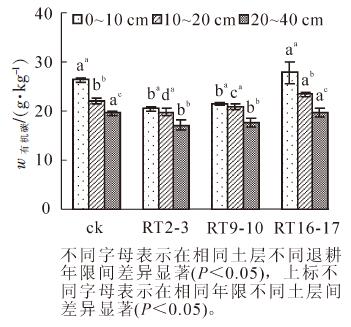-
生态化学计量学是基于生态学和化学计量学的基本原理,研究生物系统能量以及多重化学元素平衡的科学,其中以碳、氮、磷元素为主。这一研究领域可将生物学科相关的研究理论有机结合[1-2],已成为生态系统研究的新型工具之一[3]。目前,生态化学计量学的研究集中于水生生态系统、种群动态与森林演替、陆地植物生态系统的碳循环以及全球碳、氮、磷生物地球化学循环等方面[4-5],且多数从植物组织元素的角度展开[6-8]。对土壤养分的生态化学计量学研究却相对较少[9-10]。碳、氮、磷既是土壤中重要的生源要素,也是植物生长的必需养分。土壤碳、氮、磷的生态化学计量特征具有良好的指示作用,不仅可反映植物生长速度(碳氮比和碳磷比)[11],表征营养元素对生产力的限制性作用(氮磷比)[12],同时也可揭示土壤内部碳、氮、磷的循环特征(C∶N∶P)。因此,生态化学计量学特征的研究对揭示土壤养分的可获得性以及碳、氮、磷等营养元素的循环和平衡机制等方面均具有重要的意义[13]。目前,茶Camellia sinensis 园生态系统主要集中于土壤理化性质、微生物生态、团聚体、酸化等方面的探讨[14-15],就退耕植茶后的土壤生态化学计量学特征方面的研究鲜见报道。四川作为中国主要产茶区之一,植茶历史悠久,受国家“退耕还林(草)”和“天然林保护”等工程政策的影响,四川省雅安市名山区中峰乡根据其地理条件和水土、气候等资源特点形成了以“退耕植茶”为主的退耕模式。以往研究表明:随着植茶年限的延长,土壤pH值下降,酸化加剧[16-17],氟、铝逐渐富集,钙、镁等盐基离子相对缺乏[18-19],土壤结构与功能的变化尤为明显[20],影响着土壤供肥能力、茶树生长及茶园生态环境等,而这些变化在土壤碳、氮、磷及其生态化学计量特征方面的反映有待深入研究。因此,本研究选取川西低山丘陵区典型退耕植茶区为研究对象,开展不同退耕植茶年限土壤碳、氮、磷生态化学计量学特征的研究,以期为实现茶园土壤持续利用与退耕植茶工程的有效实施提供科学依据。
-
研究区位于四川盆地西缘,隶属于雅安市名山区中峰乡。该区气候属亚热带季风性湿润气候,年平均气温为15.4 ℃,无霜期294.0 d,年降水量1 500.0 mm左右,且集中在6-9月,约占全年的72.6%,属于典型的低山丘陵区。区域内原始地带性植被为亚热带常绿阔叶林,土壤为第四纪老冲积物发育而成的黄壤。目前,退耕植茶为该区主要的退耕模式,受经济因素的驱动,茶树品种不断得到了更新,以福鼎大白Camellia sinensis ‘Fuding-dabaicha’,名山白毫Camellia sinensis ‘Mingshan-baihao’,名山特早芽Camellia sinensis ‘Mingshan-tezaoya’等良种茶为主,其中福鼎大白茶因其品质高、效益好已成为该区近年来的主栽品种。从20世纪90年代末至今,形成了一定规模的退耕植茶地。茶树的种植方式为双行单株错株条植,种植密度为大行距(150 ± 15) cm,小行距(35 ± 15) cm,株距(16 ± 4) cm。茶园基肥为猪圈肥15 t·hm-2,硫酸钾型复合肥[m(氮肥) ∶ m(五氧化二磷) ∶ m(氧化钾) = 20 ∶ 8 ∶ 8] 750 kg·hm-2,在10 月中旬,沿树冠边缘垂直下方开沟,依次加入复合肥和猪圈肥,最后覆土。于次年2月中旬、5月下旬和7月下旬进行追肥,分别施用复合肥1 t·hm-2和尿素500 kg·hm-2,追肥位置与基肥相同。
-
在野外实地调查的基础上,选择集中且地理位置相对一致的退耕2~3 a(RT2-3),9~10 a(RT9-10),16~17 a(RT16-17)的福鼎大白茶园为采样对象,以邻近耕地作为对照(ck)。1个年限茶园设置5个样地,按“品”字形设置15 m × 15 m 典型样方5个·样地-1,间距约15 m,在样方内按“S”形设置5个采样点,5点土样混合作为1次重复。采样点设在树冠边缘垂直下方,按0~10,10~20和20~40 cm分层采集,同时用环刀取土以测定各土层容重、含水量等。
-
土壤容重采用环刀法测定;土壤pH值采用电位法[m(水)∶m(土)=2.5∶1.0]测定[21];土壤有机碳(SOC)采用重铬酸钾氧化法测定;土壤全氮(TN)采用半微量开氏法测定;土壤全磷(TP)采用氢氧化钠熔融-钼锑抗比色法测定[21]。
-
土壤碳氮比(C/N),碳磷比(C/P)和氮磷比(N/P)均采用质量比。数据采用统计软件DPS 7.05进行处理,方差分析采用最小显著极差法(LSD),相关图表采用Excel 2010和Origin 9.0软件制作。
-
如图 1所示:样地各土层土壤有机碳质量分数均表现为RT16-17>ck>RT9-10>RT2-3。0~10,10~20和20~40 cm土层有机碳质量分数的变化范围分别为20.49~24.84,19.80~23.43和17.15~19.80 g·kg-1。与对照地相比,随着退耕植茶年限的延长,各土层土壤有机碳质量分数均表现为先显著降低、后显著增加的趋势(P<0.05)。退耕植茶地各土层土壤有机碳质量分数均表现为RT16-17显著高于RT2-3和RT9-10,分别增加了35.86%,18.32%,15.48%和29.21%,12.36%,11.78%。16~17 a(RT16-17)以后,与对照地相比,各土层土壤有机碳质量分数分别增加了5.67%,5.67%,0.78%。退耕植茶地及对照地土壤有机碳质量分数,0~10 cm和10~20 cm土层均显著高于20~40 cm土层。
-
如图 2所示:样地各土层全氮质量分数的变化范围分别为0.78~1.20,0.71~0.98和0.54~0.85 g·kg-1。与对照地相比,随着退耕植茶年限的延长,土壤全氮质量分数表现为先显著降低,而后显著增加的变化趋势(P<0.05),与土壤有机碳变化趋势相似。0~10 cm和10~20 cm土层,土壤全氮质量分数表现为ck>RT16-17>RT9-10>RT2-3;而20~40 cm土层则表现为RT16-17>ck>RT9-10>RT2-3,对照地及RT16-17土壤全氮质量分数显著高于其他退耕植茶地,且对照地和RT16-17土壤全氮间差异不显著。与RT2-3相比,RT16-17土壤全氮质量分数在各土层分别增加了36.92%,25.49%和57.62%。就土层而言,各样地土壤全氮均随土层的加深呈降低趋势,除RT16-17以外,其余各样地土壤全氮质量分数,0~10 cm和10~20 cm土层均显著高于20~40 cm土层。
-
如图 3所示:样地各土层全磷质量分数的变化范围分别为0.51~0.75,0.52~0.57和0.50~0.53 g·kg-1。与对照地相比,10~20 cm 和20~40 cm土层,退耕植茶后土壤全磷质量分数变化较为稳定,无显著变化(P>0.05); 0~10 cm土层,RT16-17土壤全磷质量分数显著高于其他样地(P<0.05),较ck,RT2-3和RT9-10分别增加了45.63%,35.64%和29.31%;就土层而言,RT9-10土壤全磷表现为0~10 cm和10~20 cm土层显著高于20~40 cm土层;RT16-17土壤全磷质量分数却表现为0~10 cm土层显著高于其他土层。
-
如图 4所示:退耕植茶地土壤碳、氮、磷间存在极显著的正相关关系(P<0.01)。其中,碳和氮间的变化几乎同步,其线性拟合关系良好(R2=0.730 7,P<0.01);碳和磷(R2=0.327 8)及氮和磷(R2=0.130 9)之间的线性拟合程度较弱。
-
由表 2可知:不同土层各样地土壤碳氮比的变化范围分别为21.97~26.28,22.57~27.84和23.40~32.12,变异系数分别为8.1%,8.7%和15.4%。与对照地相比,随着退耕植茶年限的延长,0~10 cm和10~20 cm土层,土壤碳氮比表现为先显著增加(P<0.05),后逐渐趋于稳定;20~40 cm土层,土壤碳氮比表现为先显著增加,后显著降低的变化趋势。各土层土壤碳氮比均在RT2-3达到最大值,分别较对照地增加了19.64%,23.38%和35.07%。
表 1 样地基本情况
Table 1. Description of the sampling plots
退耕植茶地 坡度/(0) 海拔/m 面积/hm2 植被类型 ck 28 740 0.20 零散的棕叶狗尾草Setaria palmifolia RT2-3 30 742 0.4l 茶树 RT9-l0 30 742 0.75 茶树 RTl6-l7 30 742 0.67 茶树 表 2 退耕植茶地土壤碳氮比的分布特征
Table 2. Distribution of C N ratios in the soils of returning farmland to tea
土层/cm 土壤碳氮比 ck RT2-3 RT9-10 RT16-17 0-10 21.97±0.77 bb 26.28±0.92 ab 25.45±1.94 aa 26.06±1.88 aab 10-20 22.57±0.60 bab 27.84±2.10 ab 25.45±1.09 aa 26.30±2.28 aa 20-40 23.78±0.71 ba 32.12±4.03 aa 25.68±1.90 ba 23.40±1.73 bb 说明: 不同字母表示在相同土层不同退耕年限间差异显著(P<0.05),上标不同字母表示在相同年限不同土层间差异显著(P<0.05)。 -
由表 3可知:退耕植茶地土壤碳磷比的变化范围分别为37.29~51.95,36.79~43.06和34.43~39.14。与对照相比,随着退耕植茶年限的延长,0~10 cm土层,土壤碳磷比表现为先显著降低,再趋于稳定(P<0.05),其变异系数为17.6%;RT2-3,RT9-10,RT16-17较对照地分别降低了28.22%,27.56%和27.76%。10~20 cm和20~40 cm土层,退耕植茶地及对照地间土壤碳磷比均无显著差异。随着土层的加深,对照地碳磷比呈现降低的变化趋势;而退耕植茶地土壤碳磷比却无显著差异。
表 3 退耕植茶地土壤碳磷比的分布特征
Table 3. Distribution of C:P ratios in the soils of returning farmland to tea
土层/cm 土壤碳磷比 ck RT2-3 RT9-10 RT16-17 0-10 51.95±6.44 aa 37.29±1.73 ba 37.63±2.57 ba 37.53±4.96 ba 10-20 43.06±7.03 aab 38.30±4.15 aa 36.79±3.48 aa 42.02±1.66 aa 20-40 39.14±2.63 ab 34.43±7.95 aa 34.47±0.69 aa 37.85±4.38 aa 说明: 不同字母表示在相同土层不同退耕年限间差异显著(P<0.05),上标不同字母表示在相同年限不同土层间差异显著(P<0.05)。 -
由表 4可知:退耕植茶地土壤氮磷比的变化范围分别为1.42~2.37,1.37~1.91和1.10~1.65,变异系数分别为27.5%,14.9%和18.0%。0~10 cm和10~20 cm土层,对照地土壤氮磷比显著高于退耕植茶地。与对照相比,随着退耕植茶年限的延长,土壤氮磷比表现为先显著降低,后逐渐趋于稳定(P<0.05),RT2-3的各土层土壤氮磷比较对照分别降低了40.08%和27.88%。20~40 cm土层,土壤氮磷比表现为先显著降低,而后逐渐增加的变化趋势。随土层深度的加深,对照地及RT2-3土壤氮磷比均有降低趋势,而其他样地无显著变化。
表 4 退耕植茶地土壤氮磷比的分布特征
Table 4. Distribution of N:P ratios in the soils of returning farmland to tea
土层/cm 土壤氮磷比 ck RT2-3 RT9-10 RT16-17 0-10 2.37±0.32 aa 1.42±0.02 ba 1.49±0.15 ba 1.44±0.13 ba 10-20 1.91±0.29 aab 1.37±0.09 bab 1.45±0.14 ba 1.61±0.13 ba 20-40 1.65±0.06 ab 1.10±0.36 bb 1.35±0.11 aba 1.62±0.19 aa 说明: 不同字母表示在相同土层不同退耕年限间差异显著(P<0.05),上标不同字母表示在相同年限不同土层间差异显著(P<0.05)。 -
本研究结果表明:退耕植茶初期(RT2-3),土壤有机质质量分数显著下降,这主要是由于研究区土壤受退耕植茶翻耕、施肥等人为扰动作用,加速土壤有机碳的分解。同时,退耕植茶初期,地表凋落物较少,输入土壤中的有机碳较少。土壤有机质随着退耕植茶年限的延长呈现逐渐增加的趋势,主要由于随着退耕植茶年限的延长,人为扰动减少,同时归还到土壤的茶树凋落物与施入的肥料不断积累。茶农定期修剪的枝叶主要集中于表层土壤,大量茶树凋落物、草本植物残体以及根系代谢输入的有机碳直接进入表层土壤,增强了0~20 cm土层的微生物活性[22],故退耕植茶地0~10 cm和10~20 cm土层有机碳含量均显著高于20~40 cm土层。
土壤全氮是供应植物有效氮素的源和库,主要来源于土壤中植物残体分解以及合成所形成的有机质,与土壤有机碳密切相关。退耕植茶后,土壤全氮质量分数先显著下降、后显著增加,其质量分数分布与土壤有机质较为一致。这是由于土壤中植物残体分解、合成所形成的有机质。退耕植茶地中地表形成的枯枝落叶层为表层土壤全氮提供了重要来源[17]。此外,还有少部分氮来自于大气。大气中的氮必须通过固氮细菌等微生物的作用才能进入生物体,而生物活动区主要集中于土壤表层,故0~10 cm和10~20 cm土层全氮均显著高于20~40 cm土层。
磷是植物生长必需的营养元素之一,土壤中全磷质量分数可反映土壤对植被的潜在供磷能力。本研究中土壤全磷质量分数的变化较为稳定。这是由于土壤磷素的来源少,主要是岩石的风化和凋落物的归还,其质量分数主要是受土壤母质的影响,同时磷素作为一种沉积性的矿物,在土壤中移动性差,迁移缓慢,因而空间变异性小。此外,研究区凋落物随退耕植茶年限的延长呈增加的趋势,丰富的凋落物有利于磷素的积累[23];再加上肥料的逐年施入,表层土壤全磷逐渐积累,故RT16-17表层土壤全磷质量分数显著增加,而其他土层全磷无明显变化。
-
土壤碳∶氮∶磷是反映土壤碳、氮、磷循环和土壤质量的指标,是确定土壤碳、氮、磷平衡特征的主要参数,也是用于判断碳、氮、磷矿化作用和固持作用的重要指标[22]。土壤碳氮比是土壤质量的敏感指标,可以作为衡量土壤氮素矿化能力和有机质分解速率的指标。一般而言,土壤碳氮比与有机质的分解速率成反比关系[1]。当土壤碳氮比大于25时,表示有机质的积累速率大于分解速率。本研究表明:退耕植茶后,各土层土壤碳氮比的变化范围分别为21.97~26.28,22.57~27.84和23.40~32.12,均高于中国土壤碳氮比的平均值(11.9)和全球土壤碳氮比的平均值(13.33)[1],表明各退耕植茶地土壤有机质的积累速率与分解速率相对一致,且研究区有机质矿化速率较低,释放出的氮减少,为避免微生物在分解有机质的过程中出现氮素营养不足的现象[22],研究区应注意合理补充氮肥。退耕植茶地土壤碳氮比无显著差异,这也可能是由于碳氮元素对退耕植茶地环境变化的响应几乎同步,故土壤碳氮比较为稳定。已有研究表明:碳、氮作为结构性成分,其积累与消耗过程存在相对固定的比值,尽管碳、氮质量分数在空间上具有较大的变异性,但两者之间联系紧密,碳氮比相对稳定[22]。这与本研究的结果一致。
土壤碳磷比可用于衡量微生物矿化土壤有机物质释放磷或从环境中吸收固持磷素的潜力[22],可用来表示磷有效性的高低,土壤碳磷比越小,表明土壤中磷的有效性越高[1]。当土壤碳磷比<200时,表示养分的净矿化,土壤碳磷比>300时,表示养分的净固定,而当土壤碳磷比介于200~300时,表示土壤中可溶性磷浓度变化不大。本研究中,各土层土壤碳磷比的变化范围分别为37.29~51.95,36.79~43.06和34.43~39.14,均小于200,且均低于中国土壤碳磷比平均值(61.00)[10],表明退耕植茶在一定程度上提高了磷的有效性。随着退耕植茶年限的延长,土壤碳磷比呈增加趋势,表明磷的有效性随退耕植茶年限的延长呈逐渐降低的趋势,因此,在植茶过程中,可通过有机肥与磷肥的合理配施,以减少土壤对磷的固定作用,提高土壤磷的有效性。
土壤氮、磷作为植物生长必需矿质营养元素,同时也是陆地生态系统中最常见的限制性元素[24],土壤氮磷比可以作为氮饱和的诊断指标,也可以用于判断当前限制性养分[25]。本研究中,退耕植茶地土壤氮磷比在各土层均显著低于对照地,各土层氮磷比的变化范围分别为1.42~2.37,1.37~1.91和1.10~1.65,均低于中国土壤氮磷比的平均值(5.2)[10]。随着退耕植茶年限的延长,各土层土壤氮磷比呈增加趋势,表明磷素对退耕植茶地限制性逐渐增强。
-
随着退耕植茶年限的延长,土壤有机碳和全氮质量分数均有所增加,且两者的变化趋势较为一致。土壤有机碳和全氮质量分数均表现为0~10 cm和10~20 cm土层显著高于20~40 cm土层,表聚现象明显;土壤全磷质量分数在各土层中分布较为均匀。说明退耕植茶有利于土壤有机碳、全氮的积累,而对全磷的积累影响相对较小。
退耕植茶后,各土层碳氮比显著增加,且在RT2-3达到最大值;土壤碳磷比的变异性相对较小;各土层土壤氮磷比显著降低,且RT2-3达到最低值。说明退耕植茶后土壤有机质分解速率降低,为避免微生物在分解植物残体的过程中出现氮素营养不足的现象,研究区应注意合理补充氮肥,以避免茶树生长受到氮素限制。退耕植茶有利于提高土壤中磷的有效性,但随着植茶年限的延长,土壤磷有效性呈降低趋势,因此,研究区在退耕植茶工程的实施过程中,应注意对肥料种类的选择以及有机肥与磷肥的合理配施,以提高研究区土壤磷素的有效性。
Ecological stoichiometry of soil C, N, and P for returning farmland to tea plantations
-
摘要: 研究不同退耕植茶年限土壤有机碳、全氮和全磷的质量分数分布及其生态化学计量学特征,以期为退耕植茶地土壤持续利用和茶园持续发展提供理论依据。选取退耕植茶2~3 a(RT2-3), 9~10 a(RT9-10)和16~17 a(RT16-17)的各5个样地为研究对象,以邻近耕地作为对照,采用野外调查与室内分析相结合的方法,按0~10,10~20和20~40 cm土层取样,测定土壤有机碳、全氮、全磷的质量分数,并计算了碳、氮、磷之间的计量比。结果表明:随着退耕植茶年限的延长,土壤有机碳、全氮质量分数表现为先显著降低后增加的趋势(P<0.05),全磷质量分数变化较为稳定。0~10 cm土层,退耕植茶地土壤碳氮比(C/N)显著高于对照地,退耕植茶地土壤碳磷比(C/P)和氮磷比(N/P)显著低于对照地;10~20 cm土层,退耕植茶地土壤碳氮比显著高于对照地,碳磷比在各样地间均无显著差异,氮磷比则表现为对照地土壤显著高于退耕植茶地;20~40 cm土层,碳氮比表现为RT2-3显著高于其他样地,碳磷比和氮磷比在各样地间均无显著差异。退耕植茶后,土壤碳氮比显著增加,有机质分解速率降低。退耕植茶有利于土壤有机碳、全氮的积累;虽有利于提高土壤中磷的有效性,但随着植茶年限的延长,磷素对退耕植茶地限制性逐渐增强。Abstract: To provide a scientific basis for sustainable use of soil and sustainable development of tea plantations, soil organic carbon (SOC), total nitrogen (TN), and total phosphorus (TP) at different ages (2-3, 9-10, and 16-17 years old) were measured in returning farmland to tea with elemental changes in the soil profile of the tea plantations noted. Three tea plantations with different ages located in Zhongfeng Township of Mingshan District were selected as the study plots, and the near cropland was used as contrast. Adopting field investigation and indoor analysis methods, soil samples were collected from 0-10, 10-20, and 20-40 cm depths with SOC, TN, and TP being analyzed and C:N, C:P, and N:P ratios being estimated. ANOVA was performed using the DPS software (7.05). Two-way ANOVA, followed by the least significant difference (LSD) test (P<0.05), was used to compare the sites representing the different tea plantations age and soil layer. Results showed that after returning farmland to tea, SOC content and TN significantly decreased first (P<0.05) and then increased (P<0.05); whereas, changes of TP were relatively stable (P<0.05). In the 0-10 cm soil layer, C:N of returning farmland to tea was significantly higher than the control (P<0.05); whereas C:P and N:P were significantly lower than the control (P<0.05). In the 10-20 cm soil layer, C:N of returning farmland to tea was significantly higher than the control (P<0.05). In the 20-40 cm soil layer, C:N for returning farmland to tea (2-3 years old) was significantly higher than other plots (P<0.05). Also, after returning farmland to tea, the artificial disturbance decreased, which resulted in the degradation of organic matter decomposition rate. Therefore, returning farmland to tea was beneficial to SOC and TN accumulation, improved P efficiency, but limited P on tea plantations which became problematic overtime.
-
Key words:
- forest soil science /
- ecological stoichiometry /
- carbon /
- nitrogen /
- phosphorus /
- returning farmland to tea
-
表 1 样地基本情况
Table 1. Description of the sampling plots
退耕植茶地 坡度/(0) 海拔/m 面积/hm2 植被类型 ck 28 740 0.20 零散的棕叶狗尾草Setaria palmifolia RT2-3 30 742 0.4l 茶树 RT9-l0 30 742 0.75 茶树 RTl6-l7 30 742 0.67 茶树 表 2 退耕植茶地土壤碳氮比的分布特征
Table 2. Distribution of C N ratios in the soils of returning farmland to tea
土层/cm 土壤碳氮比 ck RT2-3 RT9-10 RT16-17 0-10 21.97±0.77 bb 26.28±0.92 ab 25.45±1.94 aa 26.06±1.88 aab 10-20 22.57±0.60 bab 27.84±2.10 ab 25.45±1.09 aa 26.30±2.28 aa 20-40 23.78±0.71 ba 32.12±4.03 aa 25.68±1.90 ba 23.40±1.73 bb 说明: 不同字母表示在相同土层不同退耕年限间差异显著(P<0.05),上标不同字母表示在相同年限不同土层间差异显著(P<0.05)。 表 3 退耕植茶地土壤碳磷比的分布特征
Table 3. Distribution of C:P ratios in the soils of returning farmland to tea
土层/cm 土壤碳磷比 ck RT2-3 RT9-10 RT16-17 0-10 51.95±6.44 aa 37.29±1.73 ba 37.63±2.57 ba 37.53±4.96 ba 10-20 43.06±7.03 aab 38.30±4.15 aa 36.79±3.48 aa 42.02±1.66 aa 20-40 39.14±2.63 ab 34.43±7.95 aa 34.47±0.69 aa 37.85±4.38 aa 说明: 不同字母表示在相同土层不同退耕年限间差异显著(P<0.05),上标不同字母表示在相同年限不同土层间差异显著(P<0.05)。 表 4 退耕植茶地土壤氮磷比的分布特征
Table 4. Distribution of N:P ratios in the soils of returning farmland to tea
土层/cm 土壤氮磷比 ck RT2-3 RT9-10 RT16-17 0-10 2.37±0.32 aa 1.42±0.02 ba 1.49±0.15 ba 1.44±0.13 ba 10-20 1.91±0.29 aab 1.37±0.09 bab 1.45±0.14 ba 1.61±0.13 ba 20-40 1.65±0.06 ab 1.10±0.36 bb 1.35±0.11 aba 1.62±0.19 aa 说明: 不同字母表示在相同土层不同退耕年限间差异显著(P<0.05),上标不同字母表示在相同年限不同土层间差异显著(P<0.05)。 -
[1] 王绍强, 于贵瑞. 生态系统碳氮磷元素的化学生态化学计量学特征[J]. 生态学报, 2008, 28(8):3937-3947. WANG Shaoqiang, YU Guirui. Ecological stoichiometry characteristics of ecosystem carbon, nitrogen and phosphorus elements[J]. Acta Ecol Sin, 2008, 28(8):3937-3947. [2] 曾德慧, 陈广生. 生态化学计量学:复杂生命系统奥秘的探索[J]. 植物生态学报, 2005, 29(6):1007-1019. ZENG Dehui, CHEN Guangsheng. Ecological stoichiometry:a science to explore the complexity of living systems[J]. Acta Phytoecol Sin, 2005, 29(6):1007-1019. [3] 张向茹, 马露莎, 陈亚南, 等. 黄土高原不同纬度下刺槐林土壤生态化学计量学特征研究[J]. 土壤学报, 2013, 50(4):818-825. ZHANG Xiangru, MA Lusha, CHEN Yanan, et al. Ecological stoichiometry characteristics of robinia pseudoacacia forest soil in different latitudes of loess plateau[J]. Acta Pedol Sin, 2013, 50(4):818-825. [4] RATNAM J, SANKARAN M, HANAN N P, et al. Nutrient resorption patterns of plant functional groups in a tropical savanna:Variation and functional significance[J]. Oecologia, 2008, 157(1):141-151. [5] ELSER J J, BRACKEN M E S, CLELAND E E, et al. Global analysis of nitrogen and phosphorus limitation of primary producers in freshwater, marine and terrestrial ecosystems[J]. Ecol Lett, 2007, 10(12):1135-1142. [6] 吴统贵, 陈步峰, 肖以华, 等. 珠江三角洲3种典型森林类型乔木叶片生态化学计量学[J]. 植物生态学报, 2010, 34(1):58-63. WU Tonggui, CHEN Bufeng, XIAO Yihua, et al. Leaf stoichiometry of trees in three forest types in Pearl River Delta, South China[J]. Acta Phytoecol Sin, 2010, 34(1):58-63. [7] 林丽, 李以康, 张法伟, 等. 高寒矮嵩草群落退化演替系列氮、磷生态化学计量学特征[J]. 生态学报, 2013, 33(17):5245-5251. LIN Li, LI Yikang, ZHANG Fawei, et al. Soil nitrogen and phosphorus stoichiometry in a degradation series of Kobresia humulis meadows in the Tibetan Plateau[J]. Acta Ecol Sin, 2013, 33(17):5245-5251. [8] 洪江涛, 吴建波, 王小丹. 全球气候变化对陆地植物碳氮磷生态化学计量学特征的影响[J]. 应用生态学报, 2013, 24(9):2658-2665. HONG Jiangtao, WU Jianbo, WANG Xiaodan. Effects of global climate change on the C, N, and P stoichiometry of terrestrial plants[J]. Chin J Appl Ecol, 2013, 24(9):2658-2665. [9] 赵亚芳, 徐福利, 王渭玲. 华北落叶松人工林碳氮磷生态化学计量学特征研究展望[J]. 北方园艺, 2014(17):197-203. ZHAO Yafang, XU Fuli, WANG Weiling. Research prospects in ecological stoichiometry characteristics of carbon, nitrogen and phosphorus in Larix principis-rupprechtii plantation of Qinling Mountains[J]. Northern Hortic, 2014(17):197-203. [10] TIAN Hanqin, CHEN Guangsheng, ZHANG Chi, et al. Pattern and variation of C:N:P ratios in China's soils:a synthesis of observational data[J]. Biogeochemistry, 2010, 98(1/3):139-151. [11] 罗亚勇, 张宇, 张静辉, 等. 不同退化阶段高寒草甸土壤化学计量特征[J]. 生态学杂志, 2012, 31(2):254-260. LUO Yayong, ZHANG Yu, ZHANG Jinghui, et al. Soil stoichiometry characteristics of alpine meadow at its different degradation stages[J]. Chin J Ecol, 2012, 31(2):254-260. [12] AGREN G I. The C:N:P stoichometry of autotrophs-thoery and observations[J]. Ecol Lett, 2004, 7(3):185-191. [13] 刘万德, 苏建荣, 李帅锋, 等. 云南普洱季风常绿阔叶林演替系列植物和土壤C, N, P化学计量特征[J]. 生态学报, 2010, 30(23):6581-6590. WANG Wande, SU Jianrong, LI Shuaifeng, et al. Stoichiometry study of C, N and P in plant and soil at different successional stages of monsoon evergreen broad-leaved forest in Pu'er, Yunnan Province[J]. Acta Ecol Sin, 2010, 30(23):6581-6590. [14] 魏孝荣, 邵明安. 黄土高原沟壑区小流域坡地土壤养分分布特征[J]. 生态学报, 2007, 27(2):603-612. WEI Xiaorong, SHAO Mingan. The distribution of soil nutrients on sloping land in the gully region watershed of the Loess Plateau[J]. Acta Ecol Sin, 2007, 27(2):603-612. [15] 王晟强, 郑子成, 李廷轩. 植茶年限对土壤团聚体氮、磷、钾含量变化的影响[J]. 植物营养与肥料学报, 2013, 19(6):1393-1402. WANG Shengqiang, ZHENG Zicheng, LI Tingxuan. Effects of ages of tea plantations on changes of nitrogen, phosphorus and potassium contents in soil aggregates[J]. J Plant Nutr Fert, 2013, 19(6):1393-1402. [16] 黄运湘, 曾希柏, 张杨珠, 等. 湖南省丘岗茶园土壤的酸化特征及其对土壤肥力的影响[J]. 土壤通报, 2010, 41(3):633-638. HUANG Yunxiang, ZENG Xibo, ZHANG Yangzhu, et al. Tea garden soil acidification and its impact on soil fertility in hillock of Hunan Province[J]. Chin J Soil Sci, 2010, 41(3):633-638. [17] 薛冬, 姚槐应, 黄昌勇. 不同利用年限茶园土壤矿化, 硝化作用特性[J]. 土壤学报, 2007, 44(2):373-378. XUE Dong, YAO Huaiying, HUANG Changyong. Characteristics of mineralization and nitrification in soils of tea gardens different in age[J]. Acta Pedol Sin, 2007, 44(2):373-378. [18] 颜明娟, 林琼, 吴一群, 等. 不同施氮措施对茶叶品质及茶园土壤环境的影响[J]. 生态环境学报, 2014, 23(3):452-456. YAN Mingjuan, LIN Qiong, WU Yiqun, et al. Effects of different nitrogen fertilization treatments on soil condition of tea garden and tea quality[J]. Ecol Environ Sci, 2014, 23(3):452-456. [19] 王晟强, 郑子成, 李廷轩, 等. 植茶年限对土壤团聚体中交换性盐基离子分布的影响[J]. 土壤学报, 2013, 50(5):1013-1020. WANG Shengqiang, ZHENG Zicheng, LI Tingxuan, et al. Effects of age of tea plantations on distribution of exchangeable base cations in soil aggregates[J]. Acta Pedol Sin, 2013, 50(5):1013-1020. [20] 刘苑秋, 王芳, 柯国庆, 等. 江西瑞昌石灰岩山区退耕还林对土壤有机碳的影响[J]. 应用生态学报, 2011, 22(4):885-890. LIU Yuanqiu, WANG Fang, KE Guoqing, et al. Effects of converting cultivated land into forest land on the characteristics of soil organic carbon in limestone mountain area in Ruichang, Jiangxi[J]. Chin J Appl Ecol, 2011, 22(4):885-890. [21] 鲁如坤. 土壤农业化学分析方法[M]. 北京:中国农业科技出版社, 2000:12-166. [22] BANDYOPADHYAY P K, SAHA S, MANI P K, et al. Effect of organic inputs on aggregate associated organic carbon concentration under long-term rice-wheat cropping system[J]. Geoderma, 2010, 154(3/4):379-386. [23] 郑子成, 何淑勤, 王永东, 等. 不同土地利用方式下土壤团聚体中养分的分布特征[J]. 水土保持学报, 2010, 24(3):170-174. ZHENG Zicheng, HE Shuqin, WANG Yongdong, et al. Distrbution feature of soil nutrients in aggregate under different land use[J]. J Soil Water Conserv, 2010, 24(3):170-174. [24] 程滨, 赵永军, 张文广, 等. 生态化学计量学研究进展[J]. 生态学报,2010,30(6):1628-1637. CHENG Bin, ZHAO Yongjun, ZHANG Wenguang, et al. The research advances and prospect of ecological stoichiometry[J]. Acta Ecol Sin, 2010, 30(6):1628-1637. [25] 王维奇, 仝川, 贾瑞霞,等. 不同淹水频率下湿地土壤碳氮磷生态化学计量学特征[J]. 水土保持学报, 2010, 24(3):238-242. WANG Weiqi, TONG Chuan, JIA Ruixia, et al. Ecological stoichiometry characteristics of wetland soil carbon, nitrogen and phosphorus in different water-flooded frequency[J]. J Soil Water Conserv, 2010, 24(3):238-242. -

-
链接本文:
https://zlxb.zafu.edu.cn/article/doi/10.11833/j.issn.2095-0756.2016.04.009







 下载:
下载:





